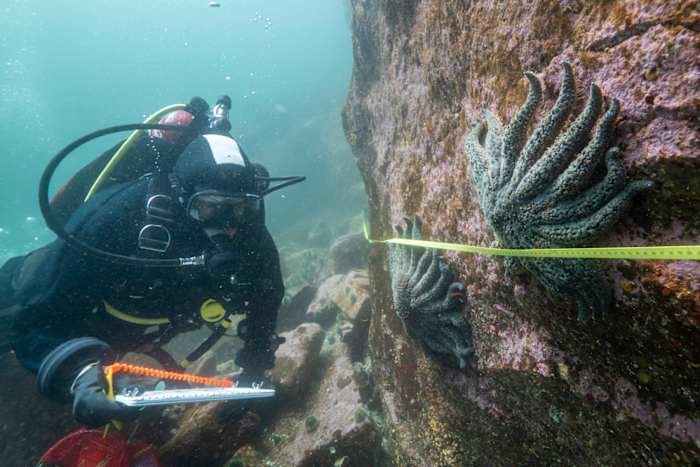In a groundbreaking revelation, scientists have finally solved the mystery behind the catastrophic die-off of more than 5 billion sea stars—more commonly known as starfish—along the Pacific coast of North America. This disturbing event, which began around 2013, has puzzled marine biologists and environmentalists for years. Now, with the cause identified, the implications reach far beyond the West Coast, even touching the interests of Orlando residents who care deeply about marine life, aquariums, and the global health of our oceans.
The Sea Star Wasting Syndrome: A Decade-Long Puzzle
The die-off event, known as Sea Star Wasting Syndrome (SSWS), was first noticed when countless sea stars began showing symptoms such as lesions, tissue decay, and ultimately, disintegration. At its height, entire populations of starfish vanished from tide pools and rocky shores, leaving a haunting absence in marine ecosystems.
For years, scientists debated the cause—was it a virus, bacteria, environmental stress, or a combination of factors? The lack of consensus made it difficult for conservationists and aquariums across the country, including those in Central Florida, to prepare for or prevent similar events.
The Scientific Breakthrough: A Viral Culprit
After almost a decade of intensive research, scientists have zeroed in on the primary culprit: a densovirus, specifically the Sea Star-Associated Densovirus (SSaDV). This tiny but deadly virus attacks the sea stars’ tissues, causing the infamous wasting symptoms. The breakthrough came from advanced genetic sequencing and laboratory experiments that conclusively linked the densovirus to the die-off.
This discovery has major implications for marine biology. By identifying the virus, researchers can now focus on understanding how it spreads, why it became so deadly, and what environmental factors—such as rising ocean temperatures—may have exacerbated its impact. This is crucial knowledge for aquariums and research institutions everywhere, including Orlando’s own SeaWorld Orlando and the Orlando Aquarium, where marine species from around the world are cared for and studied.
Ripple Effects: Why Orlando Residents Should Care
While the die-off occurred on the Pacific coast, its impact is felt nationwide. Here’s why Orlando locals should take note:
- Educational Impact: Orlando’s aquariums and science centers rely on healthy marine populations to educate visitors about ocean life. The absence of starfish—an iconic and beloved species—diminishes these experiences and underscores the fragility of marine ecosystems.
- Biodiversity Loss: Sea stars play a vital role as predators and ecosystem engineers. Their decline disrupts the food chain, which can have cascading effects on other marine animals, some of which are displayed and studied in Orlando’s educational institutions.
- Tourism & Conservation: Central Florida draws visitors interested in marine life and conservation. The story of the sea star die-off highlights the interconnectedness of ocean health and local economies, reminding us that conservation is a global responsibility.
Additionally, the knowledge gained from this event can help Orlando’s aquariums prepare for similar outbreaks, ensuring the preservation of marine biodiversity for future generations to learn from and enjoy.
What’s Next: Can Sea Stars Recover?
With the cause finally identified, scientists are hopeful that steps can be taken to support the recovery of sea star populations. Efforts are now focused on:
- Monitoring and Research: Ongoing surveillance of sea star populations helps detect any resurgence of the virus and monitor recovery rates.
- Environmental Management: Understanding the role of ocean temperature, pollution, and other stressors could lead to better management practices that protect vulnerable species.
- Public Education: Aquariums and marine centers, including those in Orlando, are ramping up educational outreach to inform the public about the importance of biodiversity and the threats facing our oceans.
Restoring sea star populations will take time. However, the collaborative effort between scientists, conservationists, and public institutions provides hope that the lessons learned will lead to stronger protections for marine life everywhere—including right here in Florida.
The Broader Picture: Protecting Our Oceans from Coast to Coast
The mystery of the sea star die-off may have been solved, but it stands as a stark reminder of the vulnerabilities in our marine ecosystems. From the Pacific coastline to the aquariums and science centers of Orlando, the health of ocean species affects us all—whether we live near the beach or in the heart of Central Florida. By staying informed and supporting marine conservation, Orlando residents can play a part in protecting the wonders of the sea for generations to come.
Conclusion: Join the Conversation!
The discovery of the cause behind the sea star die-off marks a pivotal moment in marine science and conservation. As Orlando continues to celebrate its ties to the ocean through education and tourism, the lessons from this event are more relevant than ever.
What are your thoughts about the sea star die-off and its impact on marine life and Orlando’s community? Have you seen changes in local aquariums or educational programs? <strong
















